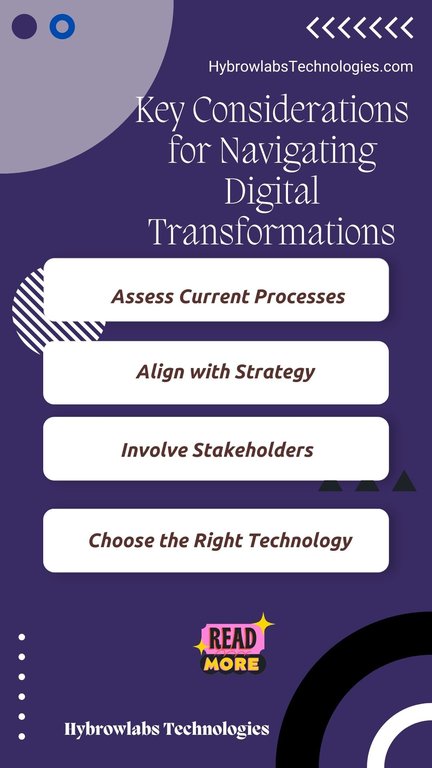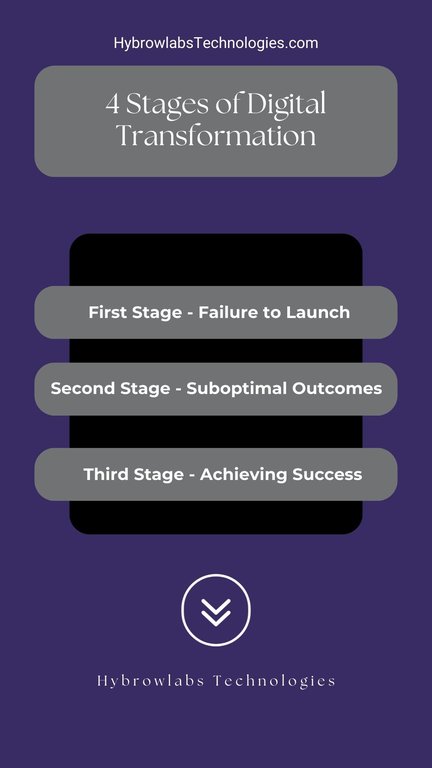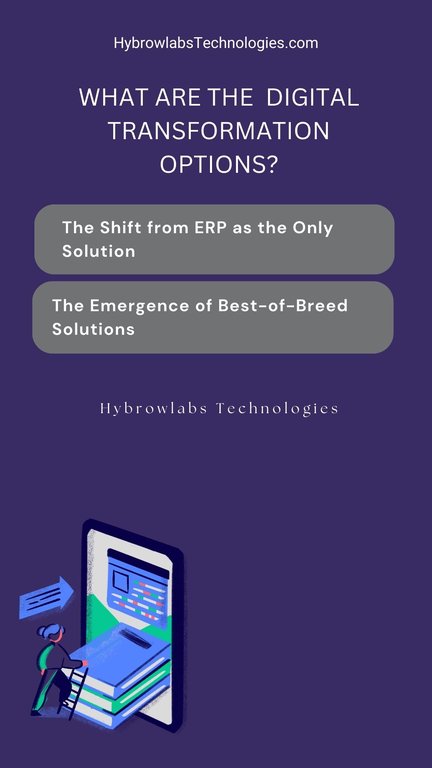What is the Future of Digital Transformations and ERP Software?
In this article we we get to know the future possibilities of Digital Transformations and ERP Software.
The realm of digital transformation is a dynamic and ever-evolving landscape, and as organizations continue to harness the power of technology to stay competitive, it's crucial to explore what the future holds for digital transformations and ERP (Enterprise Resource Planning) software. In today's interconnected world, where information flows freely and innovation is paramount, we embark on a journey to understand the trajectories and trends that will shape the future of digital transformation.
The Importance of Diverse Perspectives
Diverse perspectives are invaluable in our exploration of the digital transformation landscape. As we bring together a global team with representation from different corners of the world, it becomes evident that the power of varied viewpoints enriches our understanding. Diverse perspectives provide us with unique insights into the global intricacies of digital transformation and ERP software.
The Future of Digital Transformation
Digital transformation is not a fleeting trend; it is a relentless force that continues to shape how organizations operate. In this section, we delve into what lies ahead for digital transformation. What are the emerging technologies, methodologies, and strategies that will redefine how businesses function? As technology evolves, so do the expectations and needs of organizations, and understanding these shifts is fundamental to staying relevant in an increasingly digital world.
Key Considerations for Navigating Digital Transformations

Navigating digital transformations involves several key considerations to ensure success. Here are the essential points to keep in mind:
- Define Clear Goals: Start by articulating the specific objectives and outcomes you want to achieve through digital transformation. Having a clear vision is essential to guide your efforts.
- Assess Current Processes: Analyze your existing business processes to identify areas that need improvement or automation. Understanding the current state is crucial for making informed technology choices.
- Align with Strategy: Ensure that your digital transformation aligns with your overall business strategy. Technology investments should support and enhance your strategic goals.
- Involve Stakeholders: Engage all relevant stakeholders, including employees, customers, and partners, in the transformation process. Their input is valuable for understanding user needs and expectations.
- Choose the Right Technology: Select technology solutions that match your specific needs and goals. Consider factors like scalability, compatibility, and ease of integration.
- Prioritize Change Management: Recognize the importance of change management in ensuring a smooth transition. Invest in strategies to prepare and support your workforce through the transformation.
- Vendor Selection: Carefully evaluate potential technology vendors or partners. Consider their track record, support, and alignment with your objectives when making your choice.
- Data Security and Compliance: Prioritize data security and ensure compliance with relevant regulations. Protecting sensitive information is crucial in the digital age.
- Flexibility and Adaptability: Be prepared to adapt to evolving technology trends and market changes. Digital transformation is an ongoing process that requires flexibility to stay competitive.
- Measure and Monitor Progress: Establish key performance indicators (KPIs) to measure the success of your digital transformation. Regularly monitor progress and make adjustments as necessary.
- Budget and Resources: Allocate adequate resources and budget to support your digital transformation initiatives. Underinvestment can lead to suboptimal results.
- Continuous Learning: Encourage a culture of continuous learning and innovation within your organization. Stay up-to-date with emerging technologies and best practices.
- Mitigate Risks: Identify potential risks and develop mitigation strategies. Having a risk management plan in place can prevent unexpected setbacks.
- Communication: Maintain open and transparent communication channels throughout the transformation process. Keep all stakeholders informed and engaged.
- Celebrate Milestones: Acknowledge and celebrate achievements and milestones in your digital transformation journey. This can boost morale and motivation within your organization.
- Seek External Expertise: Consider partnering with experts or consultants who specialize in digital transformation. Their insights and experience can be invaluable in guiding your efforts.
The Connection to Digital Strategy
A well-defined digital strategy is the compass that guides an organization through the uncharted waters of digital transformation. In this segment, we explore the intricate relationship between digital transformation and digital strategy. How can organizations develop a roadmap that aligns with their business goals and leverages the full potential of digital technologies? The connection between these two facets is paramount in achieving meaningful and sustainable transformation.
Stages of Digital Transformation

In the ever-evolving landscape of digital transformation and ERP software, organizations embark on a journey that can be categorized into distinct stages. These stages offer valuable insights into the challenges and opportunities that come with this transformation.
A. First Stage - Failure to Launch
The first stage of digital transformation is a critical one, but for some organizations, it becomes a stumbling block. These are the organizations that struggle to get their transformation initiatives off the ground. The reasons for failure to launch can vary, but they often stem from fundamental issues within the organization.
1. Organizations that don't get off the ground
At this stage, organizations find themselves stuck in the planning phase, unable to initiate their digital transformation projects. Whether it's due to a lack of clear vision, inadequate resources, or resistance to change, these organizations are unable to take the crucial first steps towards transformation.
2. Addressing fundamental issues
To move beyond the first stage, organizations must identify and address the fundamental issues that hinder progress. This may involve reevaluating their vision, securing the necessary resources, and creating a culture that embraces change. Without addressing these issues, they risk remaining stagnant in the transformation process.
B. Second Stage - Suboptimal Outcomes
For many organizations, the second stage of digital transformation is where they find themselves. While they may have overcome the initial hurdles of launching their initiatives, they face a new set of challenges that lead to suboptimal outcomes.
1. Common challenges
In this stage, organizations encounter a series of common challenges. These challenges often include issues related to the implementation of new technologies, misalignment with business goals, and underutilization of the technology's potential. As a result, they struggle to achieve the expected value from their investments.
2. The struggle to realize expected value
Suboptimal outcomes are a result of organizations not fully realizing the potential benefits of their digital transformation efforts. They may have implemented new technologies, but those technologies may not be integrated effectively into their operations, or their staff may not have the necessary skills to leverage them.
3. The role of change management
One crucial aspect of overcoming the challenges in the second stage is the role of change management. Organizations must recognize that digital transformation is not solely about technology; it's also about people. Effective change management is essential to align the workforce with the transformation objectives, ensuring that the transition is smooth and value is maximized.
C. Third Stage - Achieving Success
The third stage of digital transformation is the holy grail that organizations aim to reach. It represents the moment when they not only overcome the challenges of the previous stages but also achieve a high degree of success.
1. Principles for success
In the third stage, organizations have mastered the principles that lead to success in digital transformation. These principles encompass aligning technology with business goals, optimizing processes, and ensuring that the workforce is fully engaged and skilled to harness the technology's potential. Success is not only measured by the implementation of technology but by the positive impact on the organization's performance.
2. Common pitfalls
Even in the third stage, organizations must remain vigilant to avoid common pitfalls. Complacency and neglecting continuous improvement can lead to a regression into suboptimal outcomes. Maintaining success requires ongoing commitment to best practices, adaptability, and a proactive approach to change management.
3. Avoiding the need for remediation
An essential characteristic of the third stage is the ability to avoid the need for remediation. Organizations here do not find themselves in a position where they have to fix past mistakes. They have learned from their experiences and consistently apply the principles that lead to success.
Evolution of Digital Transformation and ERP Software
A. The Rapid Pace of Technological Change
In today's ever-evolving digital landscape, technological advancements are occurring at an unprecedented rate. The rapid acceleration of technology has a profound impact on how organizations operate. As new tools and solutions continuously emerge, businesses must stay agile and adaptable to harness the opportunities these changes offer. Failure to keep up with the pace of technological change can lead to obsolescence, hindering competitiveness and growth.
B. Digital Transformation Options

- Proliferation of Technology Options
- The digital transformation ecosystem has expanded significantly in recent years. Gone are the days when ERP software was the sole solution for organizations seeking to streamline their operations. Today, businesses have access to a multitude of technology options, including cloud-based software, artificial intelligence, the Internet of Things, and more. This proliferation of options provides organizations with the flexibility to select the solutions that best align with their unique needs and objectives.
- The Shift from ERP as the Only Solution
- Historically, Enterprise Resource Planning (ERP) software reigned supreme as the primary tool for digital transformation. However, this one-size-fits-all approach is no longer the norm. Organizations now have the liberty to consider best-of-breed solutions that cater to specific business functions. This shift allows companies to tailor their digital transformation strategies to their precise requirements, enhancing efficiency and effectiveness.
- The Emergence of Best-of-Breed Solutions
- Best-of-breed solutions are specialized software applications designed to excel in a particular area, such as Human Capital Management (HCM) or Customer Relationship Management (CRM). These solutions offer in-depth functionality and often integrate seamlessly with existing systems. This emergence empowers organizations to construct a technology stack that optimally serves their diverse needs, promoting innovation and improving overall performance.
C. Navigating the Landscape
- Identifying Organizational Goals
- Successful digital transformations begin with a clear understanding of the organization's goals and objectives. By defining what you want to achieve, you can determine the technology solutions that will best support your strategic vision. This step is crucial in ensuring that technology investments align with your broader business strategy.
- Matching Technology to Specific Needs
- With a multitude of technology options available, it's essential to match the specific needs of your organization with the right solutions. A thorough evaluation of your current processes and future aspirations will help you identify the technologies that provide the most value. Customization and adaptability are key factors to consider when selecting technology solutions.
- The Importance of Vendor Selection
- Choosing the right technology vendor is a pivotal decision in your digital transformation journey. Evaluating potential vendors for their track record, support, and alignment with your goals is essential. A strategic partnership with a trusted vendor can enhance the success of your transformation efforts.
- The Challenge of Picking a Favorite Vendor
- Selecting a favorite vendor can be a complex task, as no single vendor may cater to all your needs. The decision often involves trade-offs, and there might not be a one-size-fits-all solution. However, taking a holistic approach to technology adoption, focusing on interoperability, and prioritizing compatibility with existing systems can help mitigate this challenge.
- Conclusion
The future of digital transformations and ERP software is an exciting yet complex landscape. As technology continues to advance at a breakneck pace, organizations must adapt to stay competitive. The proliferation of technology options and the shift away from one-size-fits-all ERP solutions offer newfound flexibility in crafting digital transformation strategies.
To navigate this evolving landscape successfully, it's imperative for organizations to identify their unique goals and match technology solutions to their specific needs. Vendor selection is a critical aspect, requiring careful evaluation to ensure a partnership that complements your vision.
By embracing change, staying agile, and making well-informed decisions, businesses can pave the way for a prosperous future in the realm of digital transformations. For more information, visit hybrowlabs official website today.
Frequently Asked Questions (FAQs)
1. What is digital transformation, and why is it important for businesses?
Digital transformation is the process of leveraging technology to fundamentally change the way an organization operates, delivers value to customers, and stays competitive. It's important for businesses to adapt to the evolving digital landscape to remain relevant, improve efficiency, and drive innovation.
2. How has the pace of technological change impacted organizations?
The rapid pace of technological change has forced organizations to continually adapt to new tools and solutions. Failing to keep up with these changes can lead to obsolescence and hinder competitiveness. Organizations must stay agile and flexible to harness the opportunities that technological advancements offer.
3. What are best-of-breed solutions in the context of digital transformation?
Best-of-breed solutions are specialized software applications designed to excel in specific business functions, such as HR, CRM, or finance. They offer in-depth functionality and can be integrated seamlessly with existing systems. Organizations can use best-of-breed solutions to tailor their digital transformation strategies to their precise requirements.
4. How do I choose the right technology solutions for my organization's digital transformation?
To choose the right technology solutions, start by clearly defining your organization's goals and objectives. Then, evaluate your current processes and future aspirations to identify technologies that align with your strategic vision. Vendor selection is also crucial, so research vendors carefully to find one that aligns with your goals.
5. What are the challenges of picking a favorite technology vendor in a multi-vendor ecosystem?
Picking a favorite vendor can be challenging, as there may not be a one-size-fits-all solution. Organizations often have to make trade-offs and prioritize compatibility and interoperability between systems. The key is to take a holistic approach to technology adoption that focuses on achieving your specific needs and goals.
No comments yet. Login to start a new discussion Start a new discussion